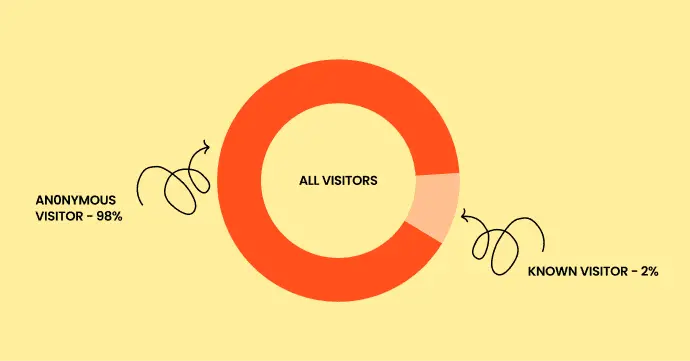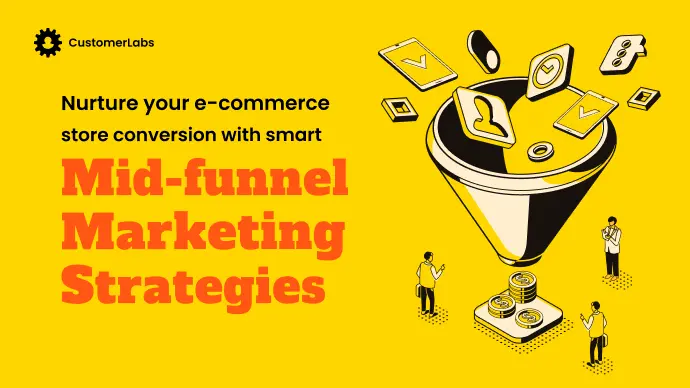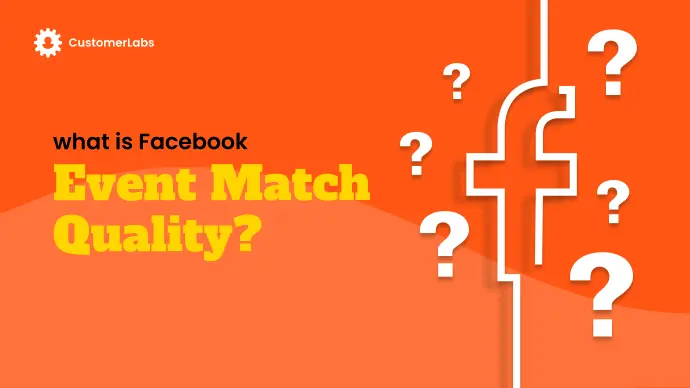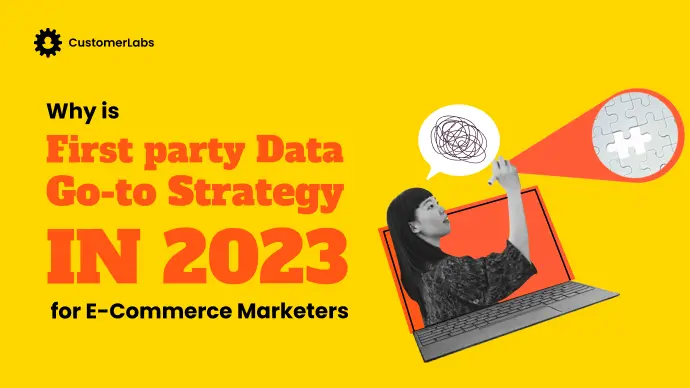Every day, thousands of people land on your website, browse through, and leave without providing any information. The majority of your visitors possess this behaviour.
These visitors are the ones who have shown interest towards your businesses, but the reasons might be different.
The concept here is, there are warm leads, you have to just nudge them to make them hot (not literally).
But tracking them without missing out on any signals is the task that you will have to ace. In this blog, we’ll understand how to effectively track anonymous website visitors and convert them into customers.
Let’s start with square one.
Who Are Anonymous Website Visitors?
Anonymous website visitors are users who browse through your website, but do not make an action like signing up or logging in.
Adding to this, they do not share any known information such as name, email address, phone number, location, etc., with your business. So, basically, the unknown users are the anonymous users.
Let’s drill down on the differences between known and unknown users.

Difference between anonymous and known users
| Anonymous Website Visitors | Known Users | |
| Who are they? | Anonymous website visitors may be either new or returning visitors to your website whose personal information is not available. | Known website visitors are existing customers or users whose personally identifiable information (PII) is available. |
| What other information can you get apart from name, email address, and phone number | Complete user behavior across the website, demographics, and other IDs** | Cart behavior (if logged in), purchase behavior, and demographics |
| What’s the difference? | They do not login or sign in to your website or do not make the purchase. Therefore, their name, email ID, etc., are not available | They login / sign in to your website or provide the personal information like name, email ID etc., in some or the other way |
| In general, how is the information collected from them? | Only advanced technology can collect details like demographics, age, etc., from anonymous website visitors. Earlier, third-party cookies used to collect and store these users’ data. | As the users are logged in, their known information is directly stored in the systems such as CRMs, and used. |
| How are they identified | The ad platforms collect the certain IDs of these users and try to map these anonymous website visitors with the accounts in their database | The ad platforms identify the known users using their name, email address, phone number, etc. |
| How are they activated | Pixel code of the ad platforms collect and send this data* | They are directly activated either through ad platforms or through email marketing campaigns or WhatsApp marketing campaigns. |
| Can you activate them now? | No** Unless you have advanced technology like 1PD Ops, that lets you activate anonymous website visitors. | Yes. You can use email marketing platforms like Klaviyo, etc. |
| How do you enhance? | If you use advanced identity resolution technology, adding the details to these anonymous profiles and later on, at some point, when the user converts, it will be a boost to the business. For example, CustomerLabs 1PD Ops’ stitcher helps you with mapping the external IDs, making a 360-degree profile of the | Combining all known user touchpoints across the website, the offline stores, events, customer support, etc., to get a complete customer journey will enhance th |
Importance of Anonymous Website Visitors
Did you know? Around 97 to 98% of the website visitors are anonymous!

Only 2 to 3% of your total website visitors are known visitors. And most of your remarketing efforts target only these known website visitors.
So what about those 98% of your anonymous website visitors?
What if I said, you can track and activate these anonymous users and pull off at least 2 to 5% more conversions from these anonymous (unknown) website visitors?
Yes! It is possible.
Now, let’s see how you can track these anonymous visitors.

How to Track Anonymous Visitors? (The Privacy-First Way)
Here’s a tidy, practical section you can drop into a blog (or landing page) that explains how it works.
1. Capture reliable signals with server-side tracking & Conversions API
Instead of relying only on browser-side pixels (which can be blocked or dropped), send events from your servers to ad platforms using server-side 1P domain tracking / Conversions API.
1P domain tracking means your tracking pixel runs under your own domain instead of a third-party one. This simple shift ensures that your data is recognized as first-party data by browsers, which means it isn’t blocked by Safari’s ITP, Firefox’s ETP, or Chrome’s privacy updates.
With tools like 1PD Ops, your tracking setup looks like this:
- Setup your own subdomain (e.g., track.yourbrand.com).
- All events are sent through this subdomain, making them appear native to your website.
- A first-party cookie is dropped under your domain, persisting across multiple sessions and devices.
This ensures that when a visitor returns days later, their past browsing behavior is stitched back seamlessly into a single profile, even if they haven’t logged in yet.
Also read on: How setup 1P Domain tracking for your WooCommerce and Shopify store.
Not just that learn how 1P Domain tracking improves attribution in Meta and Google Ads.
2. Stitch signals with identity resolution (360° profiles)
Identity resolution is the process of connecting fragmented user data across multiple touchpoints; web visits, email interactions, CRM data, offline purchases and merging them into a unified, persistent customer profile.
So this is how you should do it.
- Collect signals across platforms from your website, mobile app, CRM, ad platforms, and offline sources like POS systems.
- Assign a unique first-party ID to every visitor through 1P domain tracking and cookies.
- Stitch data automatically whenever a new piece of identifiable information (like an email or phone number) is captured.
- Create a 360° Unified profile that includes page visits, product interactions, campaign touchpoints, and purchases; all linked to the same user ID.
- Sync these enriched profiles back to your marketing destinations such as Meta, Google Ads, Klaviyo, or your analytics stack.
A unified data trail helps forecast long-term behavior, improving retention and upsell strategies.
3. Build Dynamic Segments from Anonymous Behavior
This is where it gets exciting.
Remember, you need to train every ad campaign like it’s a separate AI model. To do that, you should create dynamic segments based on behavior, even for unidentified users.
For example, let’s say:
- Added to cart but didn’t purchase
- Spent over 2 minutes on a product page
- Revisited within 7 days
- Product _viewed_more than 3times
- Cart_abandoned for more than 30 days
- Product_viewed_not_ added_to_cart
- Segment the users who have added to the Wishlist more than 10 products
- Segment the users who are first-time visitors
These behavior-based segments update in real time as new visitors interact with your site.
So instead of generic retargeting, you can run contextual, intent-driven ads like reminding a user about the exact product they checked out or offering an incentive to return.
Now, next is the activation or converting part.

Anonymous visitors Activation
You’ve done the hard part; captured anonymous visitors, tracked them under your own 1P domain, and stitched together their behaviors into unified profiles.
Now comes the most powerful part: activating those anonymous visitors across your marketing stack without ever breaching privacy or relying on third-party identifiers.
Once your segments are ready, sync your anonymous audiences to ad platforms. You can plan which platform works best for your target audience.
For instance:
- Meta Ads Manager for retargeting high-intent visitors
- Google Ads for display or search remarketing
- Klaviyo or HubSpot to trigger nurture flows
This way, you re-engage the 90% of visitors who leave without converting and you send ad platforms richer, intent-based signals that help optimize delivery.
Additionally, you can also attribute offline purchases or CRM events back to the original browsing signals (server events + identity resolution) so your ad platforms learn the full customer journey and campaign ROAS becomes more accurate.
Know how to activate anonymous website visitors using first-party data
Key Takeaways
In the world of growing concerns around privacy, it’s time you start collecting your own customer behavior data i.e. first-party data; and activate your audience throughout the marketing funnel to give a personalized experience for the users.
Anonymous website visitors are the high-intent potential purchasers who are ignored and left unnoticed. Collecting anonymous website visitor data i.e. first-party data is cheaper, accurate, and reliable for any business.
Upgrade your tracking setup with 1P Domain tracking today for free with a free trial or let’s discussion book your available slot.





